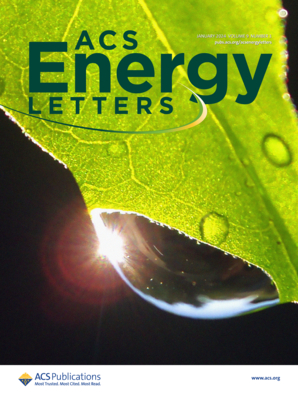Ultra-High 1.27 V VOC of Pure CsPbI3 Perovskite Solar Cells with an Efficiency of 21.8%
IF 18.2
1区 材料科学
Q1 CHEMISTRY, PHYSICAL
引用次数: 0
Abstract
There are a large number of Pb-related defects in CsPbI3 perovskite due to the easy migration of halogen ions, which cause severe non-radiative recombination, leading to huge open circuit voltage (VOC) loss and power conversion efficiency (PCE) loss for CsPbI3 perovskite solar cells (PSCs). Herein, efficient and stable CsPbI3 PSCs are obtained by introducing a chlorosilane molecule (1,2-bis(chlorodimethylsilyl)ethane, CSE) into a perovskite precursor. CSE can effectively passivate the Pb-related defects, inhibit the non-radiative recombination, and adjust the energy level arrangement of PSCs to reduce the VOC loss. The champion CsPbI3 PSC achieves a high PCE of 21.8% and an amazing VOC of 1.27 V. In addition, the hydrolytic polymerization of CSE molecules builds a moisture barrier, which increases the stability of CsPbI3 PSCs. The unencapsulated CsPbI3 PSCs retain 90% of the initial PCE after storage in air for 1500 h; the encapsulated device retains 97% of the initial PCE after operation under continuous illumination for 440 h.

纯 CsPbI3 Perovskite 太阳能电池的超高 1.27 V VOC,效率达 21.8%
由于卤素离子容易迁移,CsPbI3 包晶体中存在大量与铅有关的缺陷,从而引起严重的非辐射重组,导致 CsPbI3 包晶体太阳能电池(PSCs)的开路电压(VOC)损失和功率转换效率(PCE)损失巨大。在这里,通过将氯硅烷分子(1,2-双(氯二甲基硅基)乙烷,CSE)引入到过氧化物前驱体中,获得了高效稳定的 CsPbI3 PSC。CSE 可以有效地钝化与铅相关的缺陷,抑制非辐射重组,调整 PSC 的能级排列,从而降低挥发性有机化合物的损耗。冠军 CsPbI3 PSC 的 PCE 值高达 21.8%,VOC 值达到惊人的 1.27 V。此外,CSE 分子的水解聚合作用还能建立湿气屏障,从而提高 CsPbI3 PSC 的稳定性。未封装的 CsPbI3 PSCs 在空气中储存 1500 小时后,仍能保持 90% 的初始 PCE;封装器件在连续光照下运行 440 小时后,仍能保持 97% 的初始 PCE。
本文章由计算机程序翻译,如有差异,请以英文原文为准。
求助全文
约1分钟内获得全文
求助全文
来源期刊

ACS Energy Letters
Energy-Renewable Energy, Sustainability and the Environment
CiteScore
31.20
自引率
5.00%
发文量
469
审稿时长
1 months
期刊介绍:
ACS Energy Letters is a monthly journal that publishes papers reporting new scientific advances in energy research. The journal focuses on topics that are of interest to scientists working in the fundamental and applied sciences. Rapid publication is a central criterion for acceptance, and the journal is known for its quick publication times, with an average of 4-6 weeks from submission to web publication in As Soon As Publishable format.
ACS Energy Letters is ranked as the number one journal in the Web of Science Electrochemistry category. It also ranks within the top 10 journals for Physical Chemistry, Energy & Fuels, and Nanoscience & Nanotechnology.
The journal offers several types of articles, including Letters, Energy Express, Perspectives, Reviews, Editorials, Viewpoints and Energy Focus. Additionally, authors have the option to submit videos that summarize or support the information presented in a Perspective or Review article, which can be highlighted on the journal's website. ACS Energy Letters is abstracted and indexed in Chemical Abstracts Service/SciFinder, EBSCO-summon, PubMed, Web of Science, Scopus and Portico.
 求助内容:
求助内容: 应助结果提醒方式:
应助结果提醒方式:


